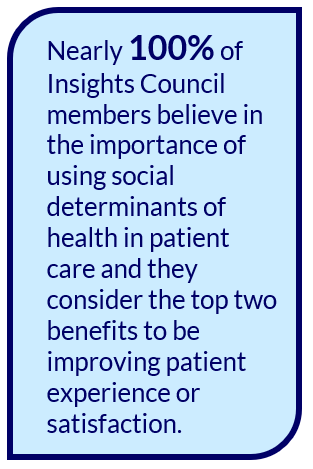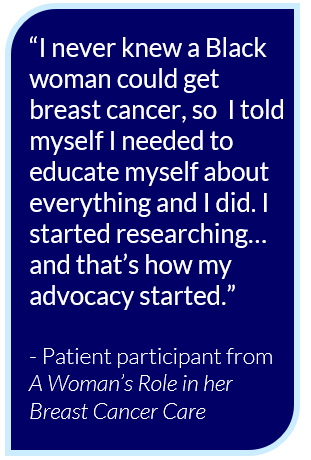Bridging knowledge gaps through the patient voice
Early in their training, healthcare professionals (HCPs) are taught pattern recognition – the practice of associating signs and symptoms in patients with a disease or condition. Relying heavily on pattern recognition can lead to knowledge gaps around differential diagnosis and treatment. For example, HCPs may be less inclined to associate heart attacks with women, eating disorders with men, and breast cancer or asthma fatalities with Black women, especially if they have never seen these issues first-hand.
“Disparities in disease care and outcomes highlight the need for greater representation of diverse populations and experiences in medical education. As leaders in elevating the patient voice, our greatest responsibility is to ensure patients receive the best possible care. Part of that responsibility is unearthing effective methods that improve clinical practice and patient outcomes,” said Sanaz Eftekhari, Vice President for Research at the Asthma and Allergy Foundation of America.
One method of representation that has proven to do so is the inclusion of the patient’s voice in continuing medical education (CME). The patient voice is the presence of the patients’ lived experiences, values, and preferences in medical education, often in the form of video testimonials.
Humanizing CME – A cultural change
The purpose of CME is to facilitate life-long learning among physicians so that their practices reflect the best medical care for their patients. Built around data, trends, research, and case studies, CME activities can inadvertently perpetuate the practice of pattern recognition. The inclusion of the patient voice can transform a CME activity by humanizing the data and research, while putting a name, face, and voice behind the disease. It often leads to an eye-opening experience for HCPs, giving them valuable insight about early and persistent symptoms, successful and unsuccessful treatments, overcoming communication barriers, and closing knowledge gaps.
The patient voice is a proven method to increase HCP engagement. CME activities that include the patient voice average 40% higher time in session compared to CME activities without the patient voice[1].
“One of the greatest drivers behind choosing a career in healthcare is the desire to make a difference in patients’ lives, so it should be no surprise that HCPs become more engaged in CME content when the patient voice is included, providing an integrative learning experience,” said Tariqa Ackbarali, MS, PhD(c), Senior Medical Director of Patient Education at PlatformQ Health. Putting purpose behind the science proves to be an effective method to educate HCPs about topics they traditionally are not exposed to, sparking an immediate desire to carry the patient’s voice through the continuum of care.
“Embedding the patient voice in CME is the start of a critical cultural change in healthcare. Every patient is different and requires a unique approach to care, the value of the patient voice goes beyond simple acknowledgement and provides an opportunity to recognize and address systemic challenges and barriers for patients. This transformative educational experience appeals to the HCP who is attuned to the patient experience and committed to providing quality care that meets the expectations of their current and future patients,” continued Ackbarali.
Understanding social determinants of health through the patient’s perspective
 The patient’s voice is a key opportunity to address social determinants of health. “There is no better way to improve cultural competence among HCPs than listening to the lived experiences of patients from diverse backgrounds,” said Matthew S. Davids, MD, MMSc, Director of Clinical Research in the Division of Lymphoma at Dana-Farber Cancer Institute and Associate Professor of Medicine at Harvard Medical School. “But including the patient voice in CME is not enough to initiate change in practice; the faculty and experts leading the activity need to amplify the importance of the patient’s testimonial and provide attendees with actionable takeaways to implement in their practice,” continued Davids.
The patient’s voice is a key opportunity to address social determinants of health. “There is no better way to improve cultural competence among HCPs than listening to the lived experiences of patients from diverse backgrounds,” said Matthew S. Davids, MD, MMSc, Director of Clinical Research in the Division of Lymphoma at Dana-Farber Cancer Institute and Associate Professor of Medicine at Harvard Medical School. “But including the patient voice in CME is not enough to initiate change in practice; the faculty and experts leading the activity need to amplify the importance of the patient’s testimonial and provide attendees with actionable takeaways to implement in their practice,” continued Davids.
In doing so, HCPs can leave a CME activity armed with the tools and confidence they need to better treat and communicate with their patients of any background, in addition to educating their fellow healthcare teammates to do the same.
“A patient-centered approach to clinical practice has quickly become the standard in healthcare and achieving it must involve a careful evaluation of the patient voice, both qualitatively and quantitatively.” said Amanda Peltier, MD, MS, Associate Professor of Neurology and Medicine and Chief of the Neuromuscular Division at Vanderbilt University Medical Center. “The data and knowledge obtained from the patient voice should be used to identify gaps in knowledge that can be addressed in future CME initiatives, creating a continuous feedback loop that improves care,” continued Peltier.
The trajectory of the patient voice will continue to hold importance in healthcare as knowledge gaps are closed, communication barriers are broken down, and health outcomes improve steadily.
—————————————————————————————————————————————–
[1] Percentage compares the average time in session of all PlatformQ Health CME programs (without a patient voice) in 2019 to PlatformQ Health CME programs with patient voice in 2020.
Have any questions about the patient voice or our CME programs? Reach out to us at digital@platformq.com.


